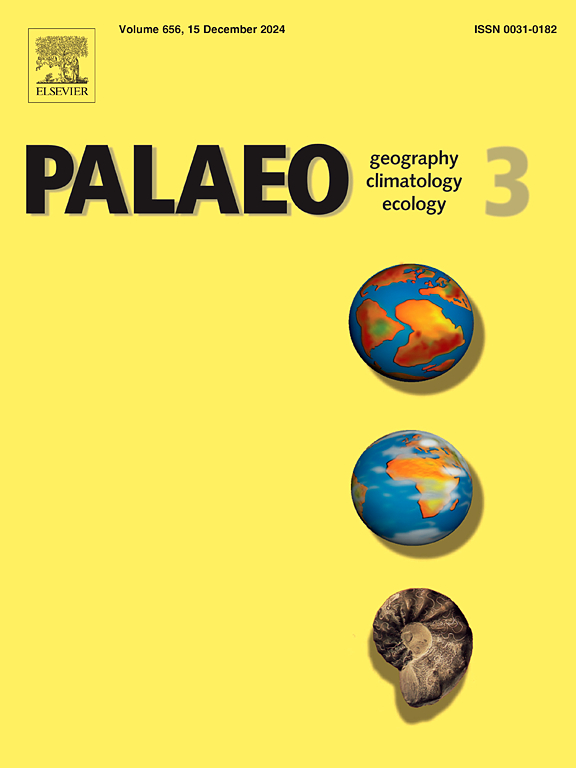New aspects of the asymmetry of the Great American Biotic Interchange based on an analysis of the spatial and temporal structure of immigrant taxa at local scale
IF 2.6
2区 地球科学
Q2 GEOGRAPHY, PHYSICAL
Palaeogeography, Palaeoclimatology, Palaeoecology
Pub Date : 2025-03-18
DOI:10.1016/j.palaeo.2025.112905
引用次数: 0
Abstract
The Great American Biotic Interchange (GABI) happened after the connection between North and South America was established, forming the Isthmus of Panama. The GABI comprised a well documented pattern characterised by an asymmetrical movement of mammalian migrants, with a higher proportion of North American taxa being found in South America than vice versa. Using mammal fossil occurrences from The Paleobiology Database (PBDB) and Generalized Linear Mixed Models, we tested if the proportion of immigrants in local assemblages presents a spatial structure with respect to the distance from the point of entrance to the new continent. We focused on two Pleistocene intervals, to evaluate if such spatial structures varied with time. We show that during early stages of the Pleistocene there was a strong negative relationship between the proportion of immigrants and distance to the point of continental connection in both North and South Americas. During the later stages of the Pleistocene a strong negative relationship was still recovered in North America; however in South America this relationship is weak, characterizing a new type of asymmetry between the continents. We conducted sensitivity analyses related to fossil dating uncertainty, the spatial definition of local assemblages and data subsetting. Our results are qualitatively robust to all sources of uncertainty. We contrast our spatially explicit results to the classical hypotheses proposed to explain the asymmetry in the proportion of immigrants at the regional scale. We advocate that the time for full expansion of immigrant ranges is a relevant aspect in structuring the spatial pattern of immigrants at the local scale but that interspecific interactions, climate and the difference between pools of temperate and tropical species might also be relevant and more explicitly incorporated in future studies of GABI's results at local scale.
基于局部尺度移民类群时空结构分析的大美洲生物交换不对称的新视角
美洲生物大交换(GABI)发生在南北美洲连接建立之后,形成了巴拿马地峡。GABI包含了一个有充分记录的模式,其特征是哺乳动物迁徙的不对称运动,在南美发现的北美类群比例高于南美发现的北美类群比例。利用来自古生物数据库(PBDB)的哺乳动物化石事件和广义线性混合模型,我们测试了移民在当地组合中的比例是否与从入口到新大陆的距离有关。我们将重点放在两个更新世区间,以评估这种空间结构是否随时间变化。我们发现,在更新世早期,北美洲和南美洲的移民比例与大陆连接点的距离之间存在很强的负相关关系。在更新世晚期,北美仍恢复了强烈的负相关关系;然而,在南美洲,这种关系很弱,表现出大陆之间一种新的不对称。我们对化石定年的不确定性、局部组合的空间定义和数据子集进行了敏感性分析。我们的结果在质量上对所有不确定性来源都是可靠的。我们将空间明确的结果与解释区域尺度上移民比例不对称的经典假设进行了对比。我们认为,移民范围全面扩张的时间是构建局地尺度移民空间格局的一个相关方面,但种间相互作用、气候以及温带和热带物种池之间的差异也可能是相关的,并更明确地纳入局地尺度GABI结果的未来研究中。
本文章由计算机程序翻译,如有差异,请以英文原文为准。
求助全文
约1分钟内获得全文
求助全文
来源期刊
CiteScore
5.90
自引率
10.00%
发文量
398
审稿时长
3.8 months
期刊介绍:
Palaeogeography, Palaeoclimatology, Palaeoecology is an international medium for the publication of high quality and multidisciplinary, original studies and comprehensive reviews in the field of palaeo-environmental geology. The journal aims at bringing together data with global implications from research in the many different disciplines involved in palaeo-environmental investigations.
By cutting across the boundaries of established sciences, it provides an interdisciplinary forum where issues of general interest can be discussed.

 求助内容:
求助内容: 应助结果提醒方式:
应助结果提醒方式:


